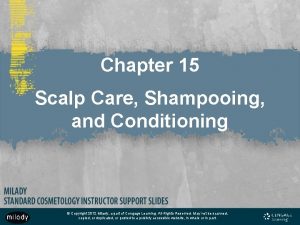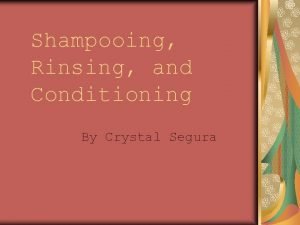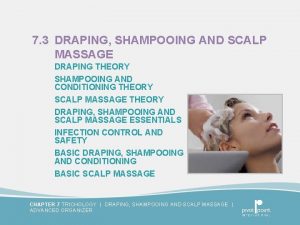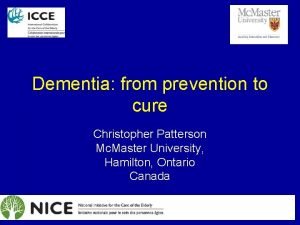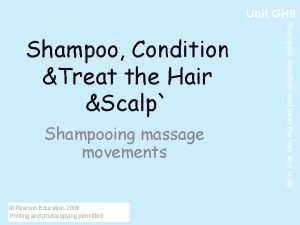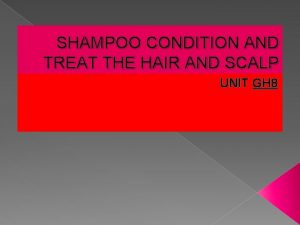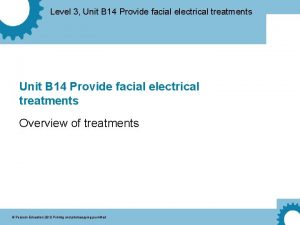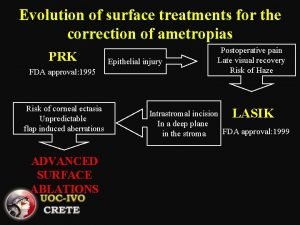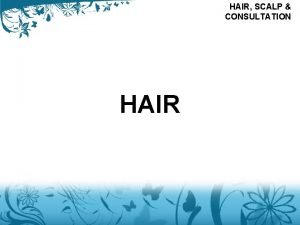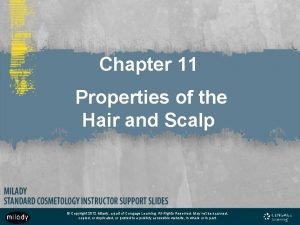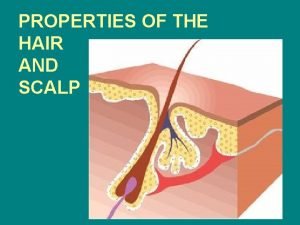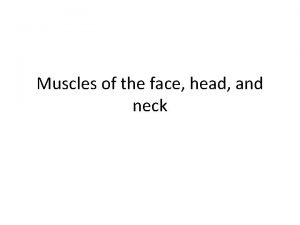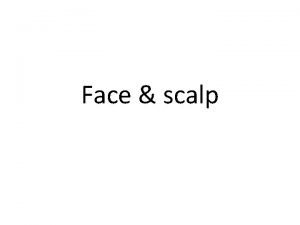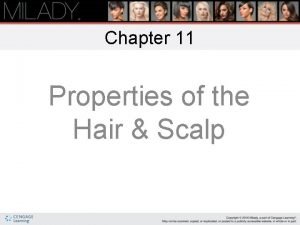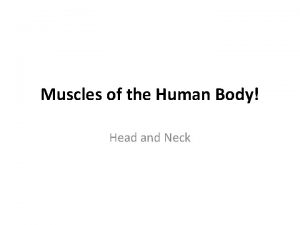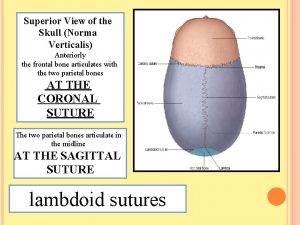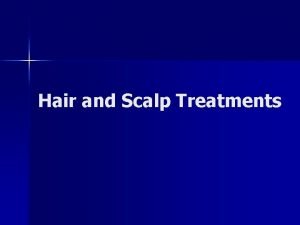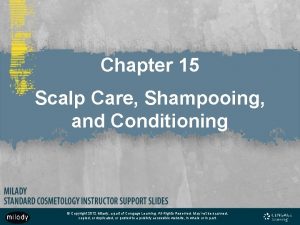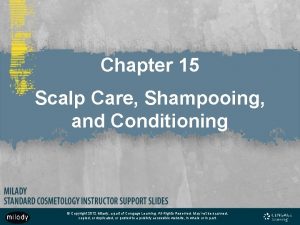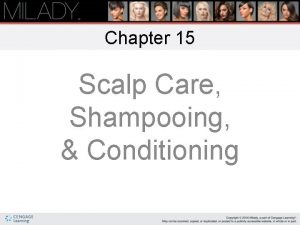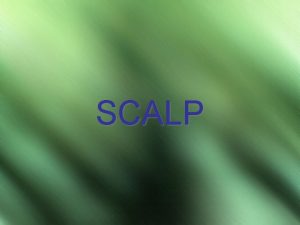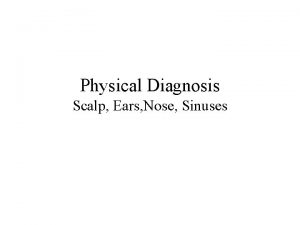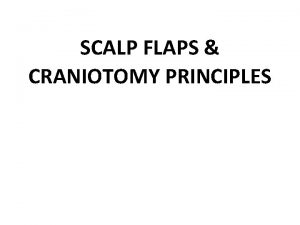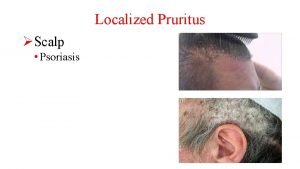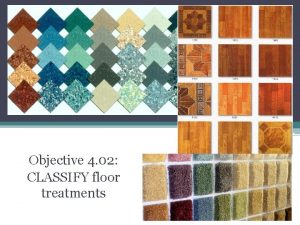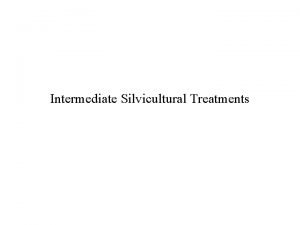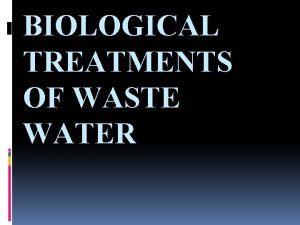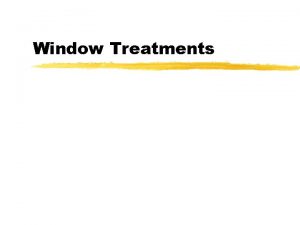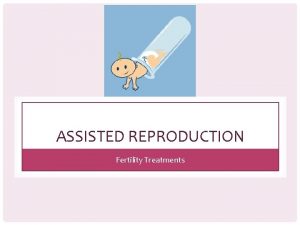SHAMPOOING AND SCALP CARE Scalp Treatments n Scalp
































- Slides: 32

SHAMPOOING AND SCALP CARE

Scalp Treatments n Scalp Care and Massage n Two Basic Requirements for healthy scalp Cleanliness and stimulation n May be performed 2 ways: n n Either before a shampoo if scalp condition is apparent Or during the shampoo Should be given with continuous and even motion that will: Stimulate the scalp n Relax the client n

Things to know n The difference between a relaxation and treatment massage n n The products you use make the difference Make sure you are following the manufacturer’s directions when a special treatment is used For simple relaxation, any conditioner may be used It is this extra service that can: n n add to the clients bill OR keep them coming back to you for that added complimentary scalp massage with their shampoo!

Important Things to Know n Scalp massages and treatments should only be performed when: A client’s intake form has been reviewed n If the client has time n Any scalp sensitivities n After you have discussed any medical conditions that may have shown up on the intake form n Note any Contraindications n High blood pressure, diabetes, circulatory issues n

What the Client Likes/Doesn’t Like n n Need to know if the client even likes massage How much pressure to use/not use Whether the client likes talking during a massage REMEMBER: When in doubt, don’t include a massage in your service!

Dry Hair and Scalp Treatments n n Used when there is a deficiency of natural oil on the scalp and hair You should select scalp products that are: n n Moisturizing and emollient ingredients Avoid using: n n n strong soaps Products using a mineral- or sulfonated-oil base Greasy preparations Lotions with high alcohol content A Scalp Steamer is used Resembles a hooded dryer

Oily Hair and Scalp Treatment n n Caused by overactive sebaceous glands You should: n Manipulate the scalp and knead it to increase blood circulation to the surface n n Any hardened sebum in the pores will be removed with gentle pressing or squeezing To normalize the function of these glands, excess sebum should be flushed out

Antidandruff Treatment n n Dandruff is the result of Malassezia- a fungus Antidandruff shampoos, conditioners, and topical lotions contain antifungal agents n n n Control dandruff by suppressing the growth of Malassezia Moisturizing scalp treatments soften and loosen scales that crust and stick to scalp Good to know: Because fungi can be resistant additional and frequent treatments may be needed

Hair Brushing n n n If done correctly, will stimulate the blood circulation to the scalp Helps remove dirt, dust, and hair-spray build up Gives added shine You should include thorough brushing as part of every shampoo and scalp treatment Brushing also allows the stylist to examine the scalp for abrasions and infections

There are 2 Exceptions to Brushing n Do Not brush or irritate the scalp before giving a chemical service Single or double-process haircolor n Highlighting n Most chemical relaxers n Some temporary and semipermanent haircolor n n Do not brush if the scalp is irritated n Make sure you’re not irritating the scalp when you are shampooing

Types of Brushes n Most highly recommended hairbrushes are those made from natural bristles Natural bristles have tiny overlapping layers or scales n Clean and add luster to the hair n n Brushes made with nylon bristles are shiny and smooth; they are more suitable for hairstyling

Understanding Shampoo n Shampoo is a good time to analyze the client’s scalp! n n If you have an assistant shampoo, make sure they alert you to any problems you need to know about Some things to check for are: n n n Dry, dehydrated hair Thinning of the hair Abnormal flaking Open wounds or scalp irritations Tick or lice infestation REMEMBER: Infectious Diseases Should Never Be Treated In A Salon

Selecting the Proper Shampoo n n Should support the health of the hair Be formulated for specific hair-types; Know whether the hair is: n natural, color-treated, fine and limp or coarse or wiry Know your clients allergies if any from the intake form and make sure those ingredients are not in the shampoo Is the hair and/or scalp oily, normal, dry or chemically processed? n A client can have oily scalp with dry hair

At Home Use n n If the client uses the right product at home, it will make a difference in how the hair behaves, moves and feels This is your chance to: educate your clients on proper hair care n make a sale n keep the client happy between services n The wrong products can make a great haircut look bad n Can negatively affect the client’s opinion of you n Can affect the outcome of a chemical service n

The p. H Scale n n n The amount of hydrogen in a solution is measured on a p. H scale and ranges from 0 -14 This range determines whether a solution is alkaline or acidic p. H of a neutral solution (7) is neither alkaline or acidic

Alkaline or Acidic n n A shampoo that is acidic will have a p. H ranging from 0 to 6. 9 Shampoos that are alkaline will have a p. H of what? n The more alkaline a shampoo is, the stronger and harsher it is n A high p. H can make the hair dry, brittle, and porous n Can cause fading in color treated hair n Acidic types match the ideal p. H more closely

The Chemistry of Water n n n Water is the most important element on Earth Known as the Universal Solvent because it can dissolve more substances than any other solvent known Fresh Water is purified by 3 ways: n n n By Sedimentation—matter sinking to the bottom By Filtration– water passing through a porous substance like filter paper or charcoal Boiling water--- 212 degrees F (110 degrees C) Distillation is when water is heated to become a vapor and the purified vapor is collected Water is readily used and important to cosmetology

How soft is your water? n Depending on the types and amounts of minerals in your water will determine: n Is the Water Hard or Soft? n Soft Water is rainwater n n Chemically softened Contains only a small amount of minerals Allows soap and shampoo to lather freely Hard Water often well-water n n Contains minerals These minerals reduce the ability of soaps and shampoos to later freely May also alter the results of hair coloring A water treatment process can soften hard water

Why Do We Need to Know This? n n n Why is it important for stylists to know what type of water the salon has? Why would a stylist need to know what type of water a client has at home? How do you think the hardness or softness of water can affect a client’s experience with a shampoo that you recommend?

Shampoo n n In order to make the best decision for your customer, you need to know what shampoo is made of……. Many shampoos have ingredients in common and it’s the small differences that make one better than another

What’s in your ‘Poo? n Water is the main ingredient in most n n Will usually be the first ingredient Usually it is purified or deionized water n n Surfactants n n Water that had impurities like calcium and magnesium, and they have been removed The second main ingredient Known as the detergent The cleansing or surface acting ingredient Moisturizers n n Aid in giving moisture as well as keeping moisture in Common additive along with: n Oil, protein, preservatives, foam enhancers, and perfume

Surfactants n A surfactant molecule has 2 ends n Hydrophilic n n Ø Water-attracting head Lipophilic n Oil-attracting tail Ø Ø During the shampoo, the Hydrophilic Head attracts the water and Lypophilic Tail attracts oil, dirt and deposits……. This causes a Push/Pull effect that causes the oil, dirt and deposits to roll up into little balls…… These balls are then lifted off the hair by the water rinse and washed away!


Types of Shampoo n p. H-Balanced n n n Conditioning n n n Balanced to the p. H of the skin and hair (4. 5 to 5. 5) Uses the addition of citric, lactic, or phosphoric acid to balance Experts believe that acid p. H is essential to preventing excessive dryness and hair damage Helps to close the hair cuticle Recommended for color-treated Also known as moisturizing shampoo Designed to make the hair appear shiny & improve manageability Protein and biotin are two examples of the agents that boost shampoos Restore moisture & elasticity, strengthen the hair shaft, and add volume Nonstripping—do not remove artificial color from the hair Medicated n n n Contains special ingredients effective for reducing dandruff and relieving scalp conditions Some must be prescribed by a physician Can be very strong and affect color May sometimes have to be left on the hair a lil longer to work

n Clarifying n Contains active chelating agent n n Also contains an equalizing agent n n n Enriches hair, helps restore moisture and make hair more manageable Use after swimming and before chemical services Balancing n For oily hair and scalp n n n binds to metals (i. e. iron and copper) and removes them Washes away excess oiliness Prevents the hair from drying out Dry n n n Used for elderly or disabled clients Also known as Powder Shampoo Can be applied at the stylists station Comes in powder or spray form Applied directly to the hair from scalp to ends Brushed through with a natural-bristle brush

n Color Enhancing n n Created by combining the surfactant base with a basic color pigment Similar to temporary color rinse n n n Is attracted to porous hair Result is only slight color change Will remove with normal shampoo Used to brighten, to add slight hint of color, to eliminate unwanted color tones For Hairpieces and Wigs n Prepared wig cleaning solution is available

Shampooing Clients with Special Needs n Clients with disabilities may require different handling n n They may come with their hair already clean If you have to wash them and they are wheelchair bound: n They choose to stay in their chair: n n Have them tilt their hair forward, facing the bowl with a towel covering their face Remove the shampoo chair and shampoo them as normal if the wheelchair is the correct height

Understanding Conditioner n n n Conditioner helps to restore the hair’s strength, give body and protect the hair against possible breakage Temporary remedy Can only repair to a certain extent Cannot improve the quality to new growth Available in 3 basic types n n n Rinse-out Treatment or repair Leave-in

n Other conditioners are: n n n Detangling rinses Cream rinses Deep Conditioners or Masks n n n Spray-on thermal protectors n n n Usually found in cream base Used to soften and improve the health of the scalp Medicated scalp lotions n n Applied before any thermal service to protect the hair Scalp conditioners n n Chemical mixture of concentrated protein and intensive moisturizer Penetrates the cuticle layer Promotes healing of the scalp Scalp astringent lotions n n Remove oil accumulation the scalp Used after a scalp treatment, before styling

What’s it made of? ? n Most contain: n silicone n n Moisture-binding humectants n n Reflects light and makes the hair appear shiny Absorb moisture or promote the retention of moisture Other ingredients n Reduce frizz or bulk up the hair (volume) • Since the hair cuticle is made up of layers or overlapping scales: • A healthy cuticle lies down smoothly and reflects light • Conditioners coat the hair to give it the appearance of being shiny and smooth!

Draping n n Proper draping is important in the salon Two Types: n Shampoo n n n Sometimes called wet draping Used for a client getting a shampoo and style or shampoo and haircut 2 terry cloth towels n n one underneath the cape and one over n After shampoo, both towels are removed and replaced with a neck stip Chemical Service n n Used for chemical services with no shampoo 2 terry cloth towels n One underneath the cape and one over

Read your procedure pages and the extra boxes in the chapter!! Know: • The Pre-Service Procedure • Important points about Dry Scalp Treatments • The proper techniques for shampooing • When to recommend or sell products to a client (at what point in the service? )
 Chapter 15 scalp care shampooing and conditioning milady
Chapter 15 scalp care shampooing and conditioning milady List and describe two types of professional draping
List and describe two types of professional draping Levels of care primary secondary tertiary
Levels of care primary secondary tertiary Shampooing rinsing and conditioning
Shampooing rinsing and conditioning Explain when and how a shampoo draping is used
Explain when and how a shampoo draping is used Dementia treatments and interventions near patterson
Dementia treatments and interventions near patterson Rotary hair massage
Rotary hair massage Rotary massage technique
Rotary massage technique Shampooing techniques
Shampooing techniques Treatments for acute renal failure
Treatments for acute renal failure Facial electrical treatments level 3
Facial electrical treatments level 3 Alternating treatments design
Alternating treatments design Hiv treatments
Hiv treatments Diabetes treatments
Diabetes treatments Advanced surface treatments
Advanced surface treatments Insomnia treatments
Insomnia treatments Health and social care values unit 2
Health and social care values unit 2 Duty of care certificate
Duty of care certificate Polii magnetici de acelasi nume se
Polii magnetici de acelasi nume se Palliative care vs hospice care
Palliative care vs hospice care Nasc pui vii
Nasc pui vii Care sunt simturile prin care sunt evocate
Care sunt simturile prin care sunt evocate Care certificate standard 8 answers
Care certificate standard 8 answers Hip fracture care clinical care standard
Hip fracture care clinical care standard Chapter 11 properties of the hair and scalp answers
Chapter 11 properties of the hair and scalp answers Tinea capitis milady
Tinea capitis milady Properties of the hair and scalp
Properties of the hair and scalp Zygomaticus major and minor
Zygomaticus major and minor Muscles on scalp
Muscles on scalp Cortex hair
Cortex hair Frontal muscles of the body
Frontal muscles of the body Galea of scalp
Galea of scalp Norma superior
Norma superior
